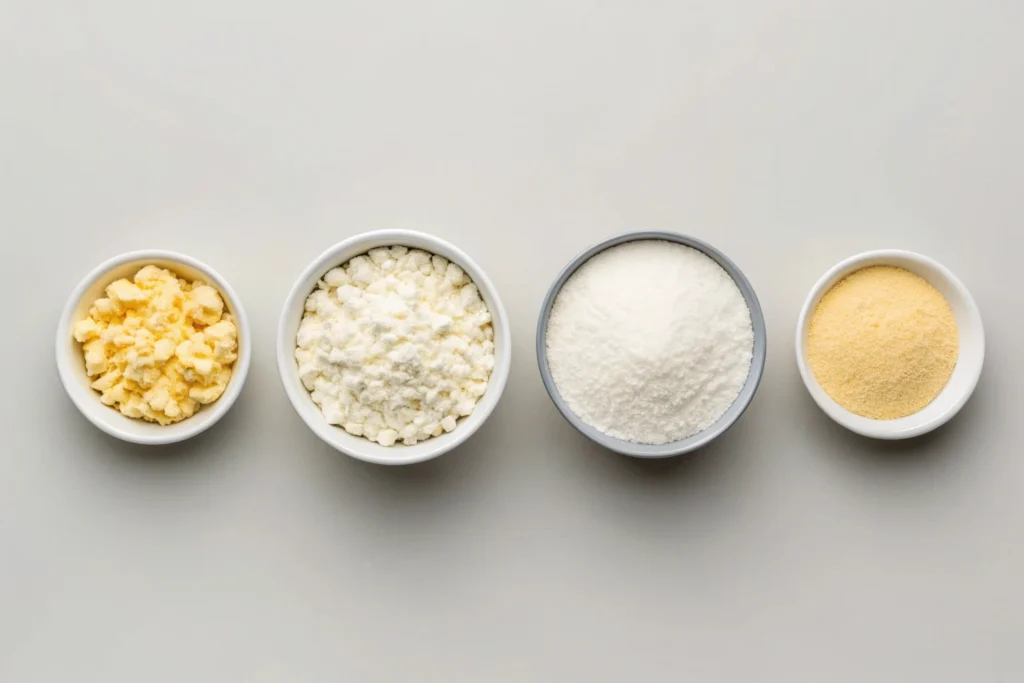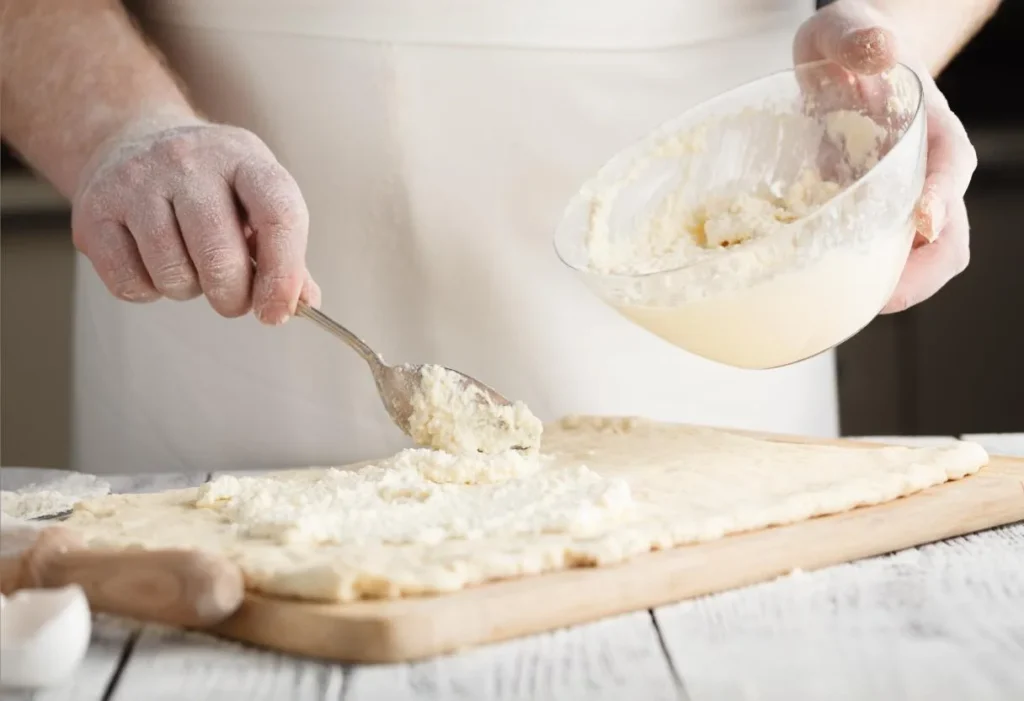Discover how to make perfect cottage cheese flatbread in this ultimate guide, from nutrition facts to mouthwatering flavor variations.
Introduction
Cottage cheese flatbread might not be the first thing that comes to mind when you think of a quick meal, yet it has all the qualities of an ideal dish. It is easy to make, relies on affordable ingredients, and offers a high-protein alternative to standard breads. Moreover, it serves as an excellent foundation for both sweet and savory toppings. Therefore, whether you are a beginner in the kitchen or an experienced cook, cottage cheese flatbread will be a fantastic addition to your culinary collection.
In today’s fast-paced food world, many home cooks appreciate recipes that satisfy hunger while delivering valuable nutrients. For that reason, this wholesome flatbread—packed with cottage cheese—brings a balanced mix of protein, vitamins, and minerals. In addition, it offers a creamy tang you do not always find in regular bread or other leavened doughs.
This comprehensive article delves into every aspect of cottage cheese flatbread. First, we will explore its background and how it stands out from other flatbreads. Next, we will look into cottage cheese’s nutritional profile and how it boosts the health quotient of this meal. Afterward, we will walk through a detailed recipe, discuss various serving suggestions, and address frequently asked questions. By the end, you will be equipped to create your very own soft and satisfying flatbread—perfect for lunches, dinners, or even a quick snack. Let’s get started!
Table of Contents

What Is Cottage Cheese Flatbread?
Cottage cheese flatbread is a delightful twist on a classic bread concept. Flatbreads themselves have been part of human diets for thousands of years, evolving across multiple cuisines in countless forms. However, adding cottage cheese to the dough transforms it into something truly special.
Understanding This Cheesy Flatbread
Cottage cheese brings a high level of protein while contributing a moist, slightly tangy flavor. Unlike standard flatbread, which typically relies on flour, water, and yeast (or baking powder) to form a dough, cottage cheese flatbread incorporates small or large curds that yield a soft yet sturdy texture. Because the cheese melts partially during cooking, it fuses seamlessly with the dough, resulting in a mildly creamy bite.
Texture and Taste
Even though the cottage cheese curds remain somewhat visible in the dough, they create pockets of creaminess. The end product is neither as dense as a pita nor as chewy as naan. Instead, it balances fluffiness and crispness—depending on how it is cooked and how thin or thick you roll the dough.
Pro Tip: For an even richer finish, you could mix in some shredded mozzarella or grated Parmesan, though the simplicity of cottage cheese alone is often enough to carry this recipe.
Nutritional Benefits of Cottage Cheese
Before diving into the specifics of how to make cottage cheese flatbread, it helps to understand why cottage cheese is such a nutrient-dense ingredient. Not only does it provide body to the dough, but it also significantly boosts the protein and vitamin content of the final product.
High-Protein Goodness
One of the main reasons cottage cheese is so popular among health enthusiasts is its impressive protein content. Protein supports muscle building, repairs tissues, and keeps you feeling full longer. Therefore, incorporating cottage cheese into a flatbread ensures every bite contributes to your daily protein intake.
Rich in Vitamins and Minerals
Cottage cheese is also known for its calcium and phosphorus, both of which are essential for healthy bones and teeth. Furthermore, it contains B vitamins that help metabolize the foods you eat, turning them into energy for the body to use. Including cottage cheese in your diet is therefore an excellent strategy for obtaining a good portion of these micronutrients.
Low-Fat Options
Many supermarkets offer reduced-fat or low-fat cottage cheese, making it easier to tailor recipes to specific dietary needs. If you prefer a leaner version of cottage cheese flatbread, opt for a lower-fat product. On the other hand, if you want a richer, creamier taste, full-fat cottage cheese can be just as nutritious when consumed in moderation.
Origins and Cultural Variations of Flatbread
Flatbreads are universally cherished and have served as culinary staples for centuries. From tortillas in Latin America to naan in South Asia, almost every region of the world celebrates its own version of this beloved bread. Therefore, it makes sense that many modern recipes incorporate local twists and ingredients to create novel flatbreads.
Ancient Roots
Historians believe flatbread likely emerged in Mesopotamia, Egypt, and other ancient civilizations as one of the earliest forms of bread. Typically, these initial breads combined flour and water, using a clay oven or an open flame for baking. Over time, flatbread recipes evolved, reflecting cultural influences, ingredient availability, and cooking styles.
Contemporary Adaptations
Today, popular variations include pita, roti, focaccia, and even pizza crust—each with unique flavors and textures. Cottage cheese flatbread has joined this expansive category as an innovative recipe that pairs a traditionally simple dough with a protein-packed dairy component. Though it is not associated with a specific geographic region, it draws inspiration from the global heritage of flatbreads while meeting modern dietary preferences.
Key Ingredients in Cottage Cheese Flatbread

When it comes to crafting this specialized flatbread, simplicity reigns supreme. However, every component plays a vital role in defining texture, flavor, and nutritional content.
1. Cottage Cheese
- Small-Curd vs. Large-Curd: Both types work well. Large-curd cottage cheese imparts bigger pockets of creaminess, while small-curd cheese may blend more seamlessly into the dough.
- Moisture Level: Cottage cheese contains a significant amount of water, so you might need to adjust the liquid in your dough recipe. Keep an eye on texture and dryness.
2. Flour Options
- All-Purpose Flour: Ideal for most home cooks, as it is easy to find and reliably produces a consistent dough.
- Whole Wheat Flour: Adds a nuttier taste and extra fiber, but might yield a denser flatbread.
- Gluten-Free Alternatives: Almond flour, oat flour, or a gluten-free blend can serve as perfect substitutions for those who follow a gluten-free lifestyle. If you choose these, you might need additional binders, like xanthan gum or an extra egg, to maintain structure.
3. Liquids and Binders
- Water or Milk: These can help adjust moisture in the dough, especially if you choose a particularly dry or wet cottage cheese.
- Eggs: Optional, but great for binding if you are aiming for a thicker or fluffier flatbread texture.
- Yogurt: In some adaptations, a bit of Greek yogurt adds tang while keeping the dough pliable.
4. Leavening Agents
- Baking Powder: Delivers a slight lift, resulting in a tender crumb.
- Yeast: Provides more rise and might create a chewier finish, akin to a traditional bread.
- No Leavening: You can skip the leavening agent altogether for a denser, cracker-like texture.
How to Make Cottage Cheese Flatbread (Step-by-Step Recipe)

Below is a thorough guide for anyone eager to whip up a fresh batch of cottage cheese flatbread. From choosing ingredients to cooking methods, this recipe offers ample flexibility to suit various tastes.
Ingredients (Makes about 6-8 medium-sized flatbreads)
- 1 cup (about 225g) cottage cheese (full-fat or low-fat, depending on preference)
- 1 ½ cups (about 190g) all-purpose flour (or whole wheat flour)
- 1 teaspoon baking powder
- ½ teaspoon salt (adjust to taste)
- 1 tablespoon olive oil (optional, for added moisture)
- ¼ cup water (approximately, adjust based on dough consistency)
- Optional: 1 egg (for extra binding), spices (e.g., garlic powder, oregano)
If you prefer a gluten-free version, swap the all-purpose flour for a gluten-free flour blend and consider adding ¼ teaspoon xanthan gum if your blend doesn’t already include it.
Step 1: Combine the Cottage Cheese and Dry Ingredients
- In a mixing bowl, whisk the flour, baking powder, and salt together.
- Add the cottage cheese to the dry mixture, stirring gently.
- Pour in the olive oil if you want a slightly more tender result.
- Start incorporating water a bit at a time, mixing until a dough begins to form.
Transition Tip: However, do not rush this step. Carefully observe the texture of your dough to avoid adding too much liquid at once.
Step 2: Knead and Rest the Dough
- Transfer the dough to a lightly floured surface.
- Knead for 3–5 minutes or until the dough becomes smooth but still slightly tacky.
- If using an egg, knead it into the dough at this point.
- Cover the dough with a clean towel and let it rest for 15 minutes. This rest allows the gluten to relax and helps create a better texture.
Step 3: Shape and Roll
- Divide the dough into 6–8 portions, depending on how large you want your flatbreads.
- Roll each piece into a ball and flatten slightly with your palm.
- Using a rolling pin, roll each portion into a circular or oval shape, about ¼-inch thick.
Transition Tip: In addition, feel free to sprinkle extra flour on the surface if the dough starts to stick.
Step 4: Cook Your Flatbread
You have several cooking methods to choose from:
- Stovetop Skillet
- Heat a nonstick or cast-iron skillet over medium heat.
- Lightly brush the skillet with oil or use cooking spray.
- Place one flatbread in the skillet and cook for 2–3 minutes per side, or until lightly browned.
- Oven-Baking
- Preheat the oven to 400°F (200°C).
- Arrange the flatbreads on a baking sheet lined with parchment paper.
- Bake for approximately 8–10 minutes, flipping halfway through if desired.
- Grilling Option
- Preheat your grill to medium heat.
- Brush each flatbread with a small amount of oil.
- Grill for 2–3 minutes per side, ensuring distinctive grill marks and a smoky flavor.
Troubleshooting Tips
- Dough Too Wet? Add more flour in small increments until manageable.
- Dough Too Dry? Incorporate a splash of water or milk to bring back moisture.
- Uneven Thickness? Use a rolling pin and measure the thickness as you go.
Flavor Variations and Topping Ideas
Cottage cheese flatbread can be enjoyed on its own. However, experimenting with herbs, spices, and toppings can quickly elevate it to a gourmet level.
Add Herbs and Spices
- Dried Herbs: Oregano, basil, or rosemary can be blended into the dough or sprinkled on top.
- Fresh Herbs: Chives, parsley, or cilantro add bright flavors when folded into the dough.
- Spice Mix: Garlic powder, onion powder, or chili flakes contribute extra zest.
Cheesy Twists
- Combine Cheeses: Pair cottage cheese with shredded mozzarella, grated Parmesan, or crumbly feta.
- Sprinkle on Top: After rolling, top your flatbread with a light layer of cheese for a golden-brown finish.
Sweet or Savory Fixes
- Sweet Varieties: Drizzle honey or agave nectar, top with fresh berries, or even sprinkle cinnamon and a bit of sugar.
- Savory Pairings: Think sautéed mushrooms, roasted bell peppers, or even grilled chicken. Since we want to keep it pork-free, consider other lean proteins or even marinated tofu.
Serving Suggestions and Pairings
Beyond standard dips or spreads, cottage cheese flatbread can complement many dishes, turning a simple meal into a feast.
Perfect Dips and Sauces
- Hummus: Classic and creamy, hummus works beautifully with the mild tang of cottage cheese.
- Pesto: Its basil, pine nuts, and olive oil flavors accentuate the richness of the flatbread.
- Tzatziki: The fresh cucumber taste further highlights the tanginess of the cottage cheese.
Ideal Side Dishes
- Garden Salads: A crisp salad pairs well with the savory notes of the flatbread.
- Vegetable Soups: Consider a comforting bowl of soup to dip your warm flatbread.
- Mini Pizza Base: Transform your cottage cheese flatbread into individual pizzas by adding tomato sauce, fresh veggies, and extra cheese on top before baking.
Related Link: For another dish that pairs well with hearty sides, check out our Dense Bean Salad to explore a protein-packed combination for a filling lunch.
Storage and Reheating Tips
When you have leftovers, the good news is that cottage cheese flatbread keeps quite well, especially if stored correctly.
Short-Term Storage
- Airtight Container: Place the cooked flatbread in a zip-top bag or sealed container.
- Room Temperature: You can keep them for up to two days at room temperature before they start losing freshness.
- Refrigeration: For longer preservation (up to four days), store the flatbread in the fridge.
Freezing and Long-Term Storage
- Freeze Dough: Roll the dough into individual portions and store them with parchment paper in between. Thaw before cooking.
- Freeze Cooked Flatbread: Cool them completely, then freeze them flat to avoid sticking. They will last up to three months.
Reheating Methods
- Skillet or Oven: Warm each piece for a few minutes to restore its soft interior and crisp exterior.
- Microwave: Quick but can result in a slightly soggy texture—keep it short, around 20–30 seconds.
- Toaster Oven: Helps regain some crispness without overcooking.
Nutritional Information (Per 100g)
Below is a general nutritional breakdown for cottage cheese flatbread made with all-purpose flour and low-fat cottage cheese. The actual values may vary based on the specific brands or additional ingredients used.
| Nutrient | Amount |
|---|---|
| Calories | ~180 kcal |
| Total Fat | 3 g |
| Saturated Fat | 1 g |
| Carbohydrates | 28 g |
| Dietary Fiber | 1 g |
| Sugars | 2 g |
| Protein | 10 g |
| Calcium | ~100 mg |
| Iron | 2 mg |
Note: Adjust the above estimates based on any extra cheese, oils, or flour substitutions you include.
Frequently Asked Questions (FAQ)
Why is my cottage cheese flatbread soggy?
Flatbread can turn soggy if it retains too much moisture. Therefore, check the water content in your cottage cheese before mixing it with the flour. Additionally, make sure your cooking surface or oven is hot enough to evaporate excess moisture. Overly thick flatbreads may also remain soggy in the center.
Does cottage cheese melt like cheese?
While cottage cheese does soften when heated, it does not melt in the same way as mozzarella or cheddar. Instead, it breaks down into creamier pockets within the dough. This effect, however, adds a distinctive, delicious texture to your cottage cheese flatbread.
How to keep cottage cheese flatbread from sticking?
Lightly flour your work surface and rolling pin when shaping the dough. Then, preheat your skillet or baking sheet. A bit of oil or cooking spray also helps keep the flatbread from sticking. Therefore, always ensure surfaces are adequately prepared.
Why is cottage cheese not keto?
Although cottage cheese is relatively low in carbohydrates compared to many dairy products, it still contains some carbs that may not fit into very strict keto diets. The curds naturally contain lactose, which is a sugar. However, if you are on a more lenient low-carb diet, you can still enjoy cottage cheese in moderation.
Can I make a vegan version of cottage cheese flatbread?
Yes. Instead of cottage cheese, use a vegan cottage cheese alternative made from soy or almonds. You can also rely on dairy-free yogurt or tofu ricotta for binding.
Conclusion
Cottage cheese flatbread epitomizes an ingenious blend of simplicity, nutrition, and irresistible taste. By including cottage cheese in the dough, you significantly increase the protein content while introducing a delightfully creamy texture. In addition, you can personalize the recipe by experimenting with different flours, herbs, spices, and toppings—suiting various dietary requirements and flavor preferences.
Whether you serve it alongside a hearty soup, use it as the base for mini pizzas, or simply enjoy it with a dab of herbed butter, cottage cheese flatbread promises to add a nourishing, versatile option to your meal rotation. Therefore, the next time you crave a comforting yet protein-packed bread alternative, give this recipe a try. You will likely discover a new favorite!
If you want another protein-rich idea, see our guide on adding Cottage Cheese in Scrambled Eggs to give your breakfast a creamy twist.
Curious about gluten-free cooking? Check out our Ultimate Gluten-Free Brunch Guide for more tips and recipes.

